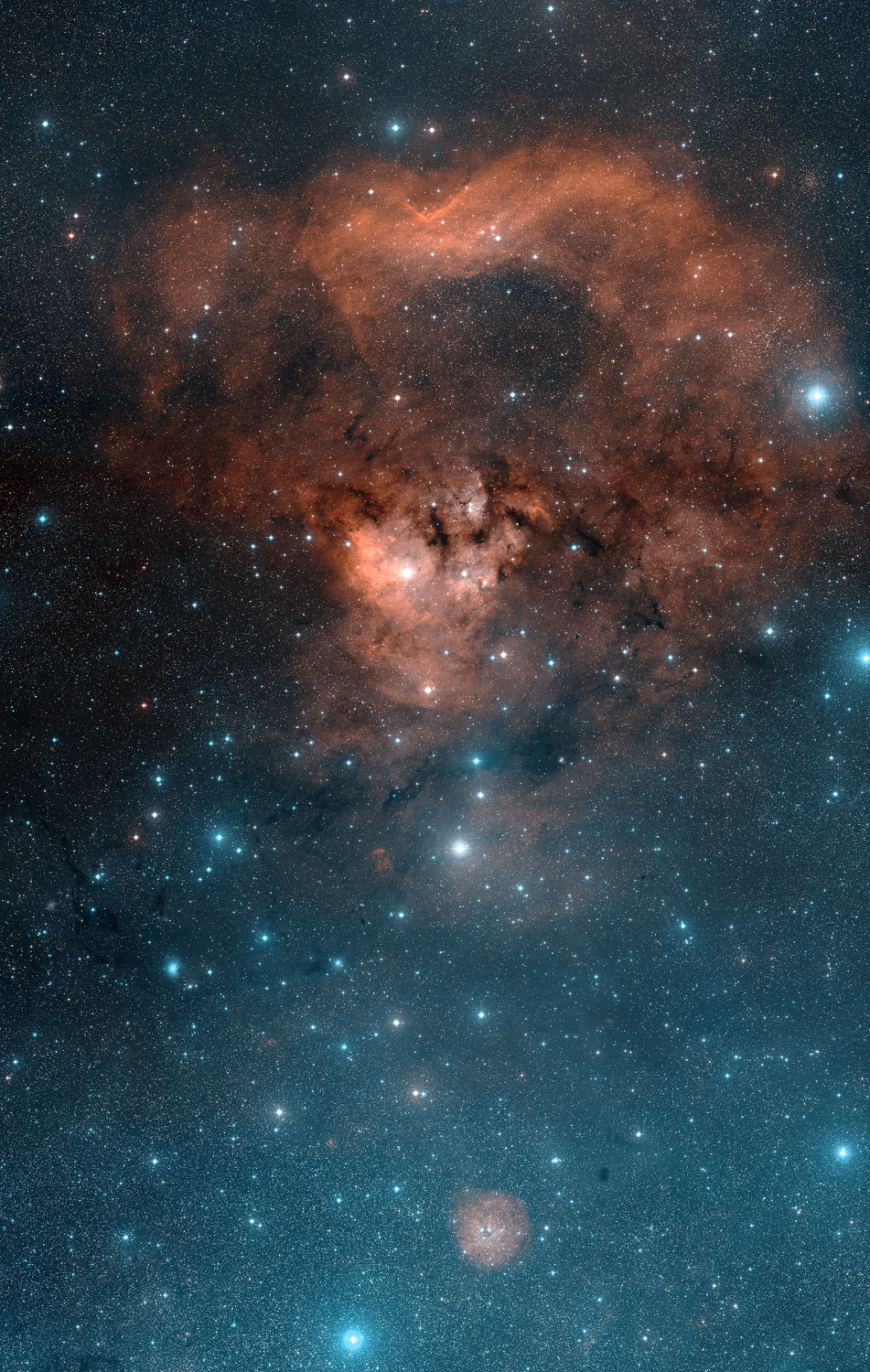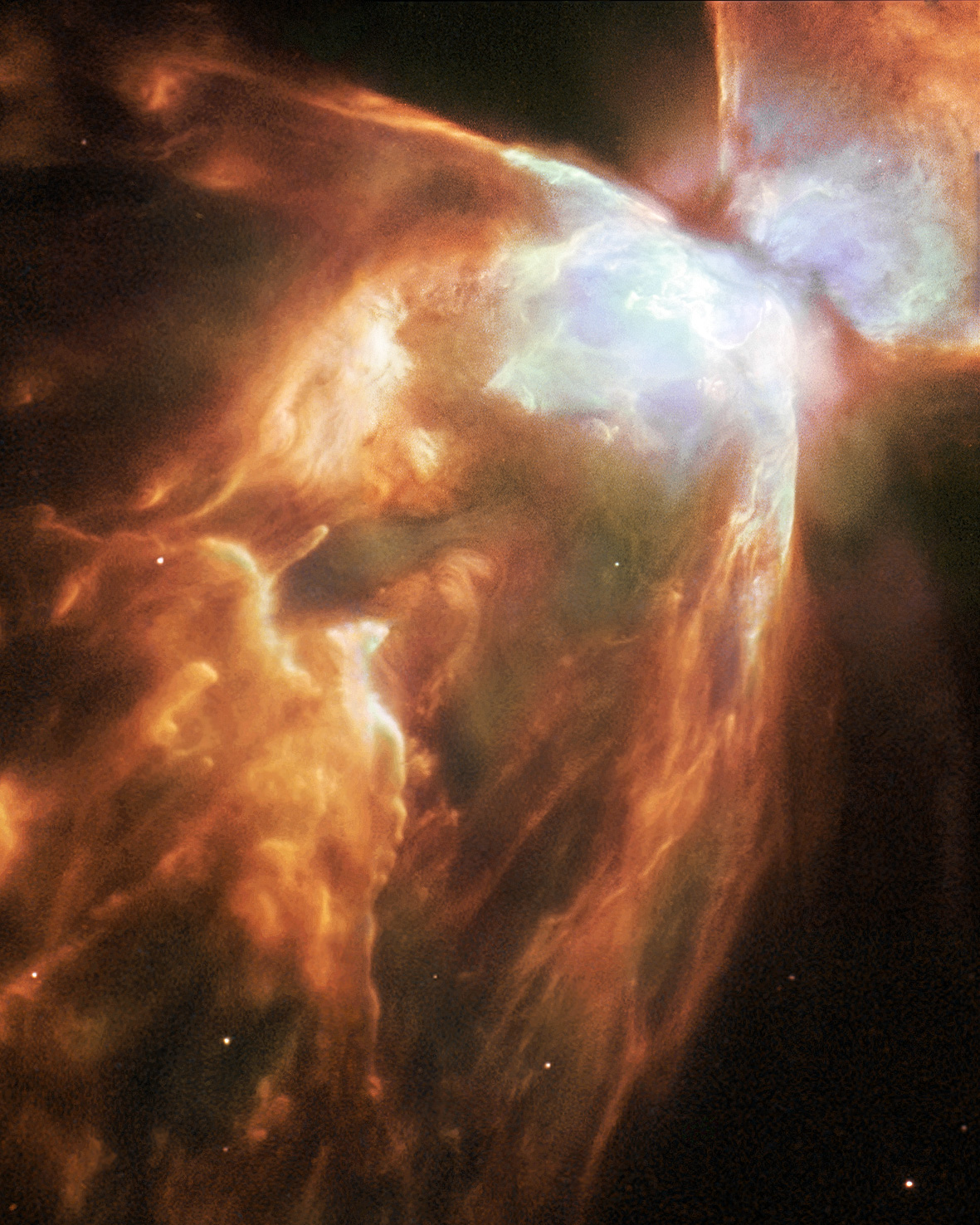|
NGC 7822
NGC 7822 is a young star forming complex in the constellation of Cepheus. The complex encompasses the emission region designated Sharpless 171, and the young cluster of stars named Berkeley 59. The complex is believed to be some 800–1000 pc distant,Majaess D., Turner D., Lane D., Moncrieff K. (2008)''The Exciting Star of the Berkeley 59/Cepheus OB4 Complex and Other Chance Variable Star Discoveries'' Journal of the American Association of Variable Star Observers, vol. 36, no. 1, p. 90Pandey et al.(2008''Stellar contents and star formation in the young star cluster Be 59'' MNRAS, Volume 383, Issue 3, pp. 1241–1258 with the younger components aged no more than a few million years. The complex also includes one of the hottest stars discovered within 1 kpc of the Sun, namely BD+66 1673, which is an eclipsing binary system consisting of an O5V that exhibits a surface temperature of nearly 45,000 K and a luminosity about 100,000 times that of the Sun. The star is one of the ... [...More Info...] [...Related Items...] OR: [Wikipedia] [Google] [Baidu] |
J2000
In astronomy, an epoch or reference epoch is a moment in time used as a reference point for some time-varying astronomical quantity. It is useful for the celestial coordinates or orbital elements of a celestial body, as they are subject to perturbations and vary with time. These time-varying astronomical quantities might include, for example, the mean longitude or mean anomaly of a body, the node of its orbit relative to a reference plane, the direction of the apogee or aphelion of its orbit, or the size of the major axis of its orbit. The main use of astronomical quantities specified in this way is to calculate other relevant parameters of motion, in order to predict future positions and velocities. The applied tools of the disciplines of celestial mechanics or its subfield orbital mechanics (for predicting orbital paths and positions for bodies in motion under the gravitational effects of other bodies) can be used to generate an ephemeris, a table of values giving the positions ... [...More Info...] [...Related Items...] OR: [Wikipedia] [Google] [Baidu] |
Cepheus (constellation)
Cepheus is a constellation in the far northern sky, named after Cepheus, a king of Aethiopia in Greek mythology. It is one of the 48 constellations listed by the second century astronomer Ptolemy, and it remains one of the 88 constellations in the modern times. The constellation's brightest star is Alpha Cephei, with an apparent magnitude of 2.5. Delta Cephei is the prototype of an important class of star known as a Cepheid variable. RW Cephei, an orange hypergiant, together with the red supergiants Mu Cephei, MY Cephei, SW Cephei, VV Cephei, and V354 Cephei are among the largest stars known. In addition, Cepheus also has the hyperluminous quasar S5 0014+81, which hosts an ultramassive black hole in its core, reported at 40 billion solar masses, about 10,000 times more massive than the central black hole of the Milky Way, making this among the most massive black holes currently known. This paper does acknowledge the possibility of an optical illusion that would cause an ... [...More Info...] [...Related Items...] OR: [Wikipedia] [Google] [Baidu] |
Sharpless Catalog
The Sharpless catalog is a list of 313 H II regions (emission nebulae) intended to be comprehensive north of declination −27°. (It does include some nebulae south of that declination as well.) The first edition was published in 1953 with 142 objects (Sh1), and the second and final version was published by US astronomer Stewart Sharpless in 1959 with 312 objects. Sharpless also includes some planetary nebulae and supernova remnants, in addition to H II regions. In 1953 Stewart Sharpless joined the staff of the United States Naval Observatory Flagstaff Station, where he surveyed and cataloged H II regions of the Milky Way using the images from the Palomar Sky Survey. From this work Sharpless published his catalog of H II regions in two editions: the first in 1953, with 142 nebula; and the second and final edition in 1959, with 312 nebulae.Stewart SharplessA Catalogue of H II Regions ''Astrophysical Journal'' Supplement, vol. 4, p.257, 1959 Sharpless coordina ... [...More Info...] [...Related Items...] OR: [Wikipedia] [Google] [Baidu] |
BD+66 1673
BD, Bd or bd may refer to: In arts and entertainment * B. D. (Doonesbury), a major character in the ''Doonesbury'' comic strip * '' Bande dessinée'' (or "bédé"), a French term for comics * Bass drum, in sheet music notation * Brahe Djäknar, a Finnish choir * Broder Daniel, a Swedish indie pop band * '' Ben Drowned'', a web serial and web series, focused on the character of the same name * ВD, shorthand name for the Russian gaming magazine, ''Velikij Drakon'', where the "В" character is actually the Russian letter "ve". * Bette Davis's production company In business Business / Technology * B&D Australia, manufacturing company * Big data, a marketing term for technology of large data sets * Broker-dealer * Business day, a day of the week on which business is conducted * Business development, techniques aimed at attracting customers and penetrating markets * Business directory, a website or printed listing of information which lists all businesses within some categor ... [...More Info...] [...Related Items...] OR: [Wikipedia] [Google] [Baidu] |
Eclipsing Binary
A binary star is a system of two stars that are gravitationally bound to and in orbit around each other. Binary stars in the night sky that are seen as a single object to the naked eye are often resolved using a telescope as separate stars, in which case they are called ''visual binaries''. Many visual binaries have long orbital periods of several centuries or millennia and therefore have orbits which are uncertain or poorly known. They may also be detected by indirect techniques, such as spectroscopy (''spectroscopic binaries'') or astrometry (''astrometric binaries''). If a binary star happens to orbit in a plane along our line of sight, its components will eclipse and transit each other; these pairs are called ''eclipsing binaries'', or, together with other binaries that change brightness as they orbit, ''photometric binaries''. If components in binary star systems are close enough they can gravitationally distort their mutual outer stellar atmospheres. In some cases, the ... [...More Info...] [...Related Items...] OR: [Wikipedia] [Google] [Baidu] |
Pillars Of Creation
''Pillars of Creation'' is a photograph taken by the Hubble Space Telescope of elephant trunks of interstellar gas and dust in the Eagle Nebula, in the Serpens constellation, some from Earth. These elephant trunks had been discovered by John Charles Duncan in 1920 on a plate made with the Mount Wilson Observatory 60-inch telescope. They are named so because the gas and dust are in the process of creating new stars, while also being eroded by the light from nearby stars that have recently formed.Embryonic Stars Emerge from Interstellar "Eggs" Hubble news release Taken on April 1, 1995, it was named one of the top ten photographs from Hubble by Space.com. The |
Elephant Trunk (astronomy)
Elephant trunks (more formally, cold molecular pillars) are a type of interstellar matter formations found in molecular clouds. They are located in the neighborhood of massive O type and B type stars, which, through their intense radiation, can create expanding regions of ionized gas known as H II regions. Elephant trunks resemble massive pillars or columns of gas and dust, but they come in various shapes, lengths, and colors. Astronomers study elephant trunks because of their unique formation process and use 2-D and 3-D simulations to try to understand how this phenomenon occurs. Formation O type and B type stars are a classification of stars that strongly emit ultraviolet (UV) radiation. The UV radiation causes the surrounding cloud of hydrogen gas to ionize, forming H II regions. The gas does not ionize evenly throughout the cloud, therefore there are clumps of denser gas scattered throughout the cloud. These dense clumps are called evaporating gaseous globules (EGGs), an ... [...More Info...] [...Related Items...] OR: [Wikipedia] [Google] [Baidu] |
NGC Objects
The ''New General Catalogue of Nebulae and Clusters of Stars'' (abbreviated NGC) is an astronomical catalogue of deep-sky objects compiled by John Louis Emil Dreyer in 1888. The NGC contains 7,840 objects, including galaxies, star clusters and emission nebulae. Dreyer published two supplements to the NGC in 1895 and 1908, known as the ''Index Catalogues'' (abbreviated IC), describing a further 5,386 astronomical objects. Thousands of these objects are best known by their NGC or IC numbers, which remain in widespread use. The NGC expanded and consolidated the cataloguing work of William and Caroline Herschel, and John Herschel's '' General Catalogue of Nebulae and Clusters of Stars''. Objects south of the celestial equator are catalogued somewhat less thoroughly, but many were included based on observation by John Herschel or James Dunlop. The NGC contained multiple errors, but attempts to eliminate them were made by the ''Revised New General Catalogue'' (RNGC) by Jack W. ... [...More Info...] [...Related Items...] OR: [Wikipedia] [Google] [Baidu] |
Sharpless Objects
Sharpless is a surname. Notable people with the surname include: *Bevan Sharpless, solar system astronomer * Karl Barry Sharpless, American chemist and Nobel prize winner * Josh Sharpless, baseball player *Christopher Sharpless, 1988 Winter Olympics bobsledder *Mattie R. Sharpless (born 1942), American diplomat * Stewart Sharpless, galactic astronomer **Sharpless catalog, a 20th-century astronomical catalog with 313 items * Isaac Sharpless, educator * Norman Sharpless, American oncologist and director of the National Cancer Institute * Disappearance of Toni Sharpless, an American nurse who disappeared in 2009 Fictional characters *A character in Madama Butterfly See also * Sharpless asymmetric dihydroxylation, a chemical reaction * Sharpless epoxidation, a chemical reaction *Sharpless oxyamination The Sharpless oxyamination (often known as Sharpless aminohydroxylation) is the chemical reaction that converts an alkene to a vicinal amino alcohol. The reaction is related to the Shar ... [...More Info...] [...Related Items...] OR: [Wikipedia] [Google] [Baidu] |
Emission Nebulae
An emission nebula is a nebula formed of ionized gases that emit light of various wavelengths. The most common source of ionization is high-energy ultraviolet photons emitted from a nearby hot star. Among the several different types of emission nebulae are H II regions, in which star formation is taking place and young, massive stars are the source of the ionizing photons; and planetary nebulae, in which a dying star has thrown off its outer layers, with the exposed hot core then ionizing them. General information Usually, a young star will ionize part of the same cloud from which it was born, although only massive, hot stars can release sufficient energy to ionize a significant part of a cloud. In many emission nebulae, an entire cluster of young stars is contributing energy. Stars that are cooler than around 25,000K don't give off enough ultraviolet radiation with wavelengths shorter than 91.2nm (the wavelength needed in order to ionize Hydrogen atoms). This results in the ... [...More Info...] [...Related Items...] OR: [Wikipedia] [Google] [Baidu] |
Open Clusters
An open cluster is a type of star cluster made of up to a few thousand stars that were formed from the same giant molecular cloud and have roughly the same age. More than 1,100 open clusters have been discovered within the Milky Way galaxy, and many more are thought to exist. They are loosely bound by mutual gravitational attraction and become disrupted by close encounters with other clusters and clouds of gas as they orbit the Galactic Center. This can result in a migration to the main body of the galaxy and a loss of cluster members through internal close encounters. Open clusters generally survive for a few hundred million years, with the most massive ones surviving for a few billion years. In contrast, the more massive globular clusters of stars exert a stronger gravitational attraction on their members, and can survive for longer. Open clusters have been found only in spiral and irregular galaxies, in which active star formation is occurring. Young open clusters may be co ... [...More Info...] [...Related Items...] OR: [Wikipedia] [Google] [Baidu] |







